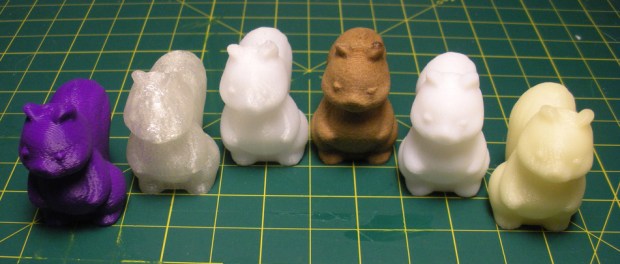
One of the exciting things about Maker Faire is seeing the technological progress year over year. Case in point, 3D-printers. Last World Maker Faire the 3D-printing village was filled with a whole bunch of competing printers. This year promises to explore the category a little more widely as add-ons, whether they be new materials or 3D scanners, take stage.
Let’s check out some of the innovating presentations and exhibits you’ll encounter at World Maker Faire in New York:
Advanced Materials for 3D Printing
Matt Stultz will give a talk on exploring new and innovative materials for use in 3D-printers. In his talk he’ll explain that with 3D-printers evening out in quality, the new frontier is exploring materials beyond the trusty ABS and PLA.
(I)n the past year we have seen a flood of new materials hit the market that can completely alter the properties of your final print. Most people though are not adopting these because they either don’t know about them, don’t know the advantages of them, or are afraid they might damage their machines. I will show that many of these materials are easy to get started with (some of them easier than ABS or PLA) and that their abilities can change the possibilities of what we can use 3D printers for. I will be showing off Nylons, PLA variants, ABS variants, HIPS, PET, and maybe a few surprises.
Matt will be presenting on the 3D-Printing Stage at 3:30 pm on Saturday, September 21.
MakerBot Digitizer Debuts

They have new software, MakerWare for Digitizer, that converts the dot pattern to a mesh, claiming 200,000 triangles of mesh and able to capture details as small as 0.5mm. It takes about 12 minutes to create the mesh.
MakerBot adds value by making the scanning process elegantly simple. You can initiate a scan with only two clicks of your mouse, and output your files as 3D-printer-friendly .STLs, and share to Thingiverse right from the drop-down menu. That said, and despite the $1,400 price tag, the gadget is clearly designed for, as the MakerBot site puts it, for “experimenters and visionaries” — it’s occupying a spot between ridiculously expensive pro scanners and $100 Kinect rigs.
MakerBot Industries CEO Bre Pettis will present the Digitizer to the Maker Faire throngs at 1pm on the Innovation Stage.
3DP a Mars Settlement

When humans eventually settle the Red Planet they will rely heavily on fabrication tools in a lab similar to the hackerspaces and makerlabs we work and play in. In extreme environments far away from Earth, future pioneers will use polymer raw materials from Martian air and water to 3D print and hack themselves a home on Mars. The Mars Foundation in conjunction with HI-SEAS and Aleph Objects are now testing some of these concepts with a Lulzbot 3D printer at a prototype Mars base in Hawaii.
One of the most critical aspects of the project is to develop a process for creating printable polymers out of water, air, and Martian regolith. Since the Red Planet is 35 million miles away, waiting for printer stocks takes a back seat to manufacturing your own! Casey’s talk will take place at Sunday 3:30pm on the Make: 3D Printing Stage.
Digital/Art

The Reverse Abstraction series begins with a simple premise: that humans and computers perceive the world through different languages, and what is concrete for one is abstract for the other. The objects and shapes so familiar in human art can be neither perceived nor conceived by computers in their original form. Likewise, the codes that are so familiar to a computer are merely scattered symbols to human sensibility. The Reverse Abstraction series attempts to bridge the gap by constructing traditional objects in dual forms: as the classical object and as the hexadecimal and binary codes that represent them.
Ashley successfully kickstarted Reverse Abstraction where she re-created the iconic Joseph Kosuth chair in hex and printed out on a MakerBot. Her presentation will take place on Sunday at 2:30 on the Make: 3D Printing Stage.
3D Printing Trains at 1:1
Chris Thorpe mostly just wanted to build models of trains and couldn’t find the ones he wanted at the right scale with the proper craftsmanship. The only solution was to create his own. Chris sent measurements of a slate wagon to a 3D modeler who recreated the design. He got the parts back from 3D-printing service Shapeways and putting it together was an eye-opening experience for him. Chris discovered that the scalability of 3D models is their killer attribute, because train builders want to create their designs in multiple scales.

Chris has a couple of great blog posts where he discusses the project and scans the locomotive. His presentation will take place at 1:30 Saturday at the Make: 3D Printing Stage.
Using 3DP as an Artistic Medium
Artist Shane Hope‘s will be exhibiting his 3D-printed art at Maker Faire. Shane’s art visualizes molecular data using layers of 3D-printed materials and paint. He uses protein files from research repositories, scientific visualization software PyMOL, modified with Python algorithms and tweaked in MeshLab and Blender.
What is fascinating for me is how Shane is pushing 3D printing as a medium to be reckoned with, printing using hand-colored filament on one of his four RepRaps and layering hundreds of visualizations in each painting. Be sure to check out Shane’s work in the 3D Printing Village at World Maker Faire.
ADVERTISEMENT








